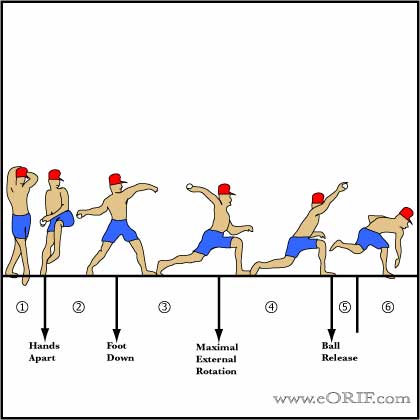 |
Throwing Athlete Shoulder Pathology
- Acquired posteroinferior capsular contracture, generally in the throwing athlete, initiates a pathologic cascade, which can lead to high shear stresses on the posterosuperior labrum and biceps tendon insertion occuring during the late-cocking phase of throwing which can lead to SLAP lesions/ dead arm syndrome.
- Increased ER of the shoulder may cause RTC abrasion/tearing against the posterosuperior glenoid. Repetitive twisting of the rotator cuff fibers may lead to torsional overload and shear failure of the cuff fibers generally on the articular side. (Burkhart SS, Arthroscopy 2003;19:404).
- Rotator cuff tendinosis in the overhead athlete is generally not related to impingement and is an overuse injury. Rest and supervised rehab is generally successful treatment.
- 5 phases of throwing: wind-up, cocking, acceleration, deceleration, follow-through.
Wind-up:
Early Cocking
Late Cocking: Quadrilateral Space Syndrome, SLAP Tear, Rotator Cuff Tear, Anterior-Inferior Glenohumeral Instability,
Acceleration: Scapulothoracic Bursitis, Internal Impingement, Rotator Cuff Tear
Deceleration: Subacromial Impingement, SLAP Tear, Rotator Cuff Tear,
Follow-through:
- Throwing athlete injuries are often associated with Scapular Dyskinesis.
- Phases of Throwing: Wind-up, early cocking, late cocking, acceleration, deceleration, follow through.
- Bennett Lesion: mineralization of the posterioinferior glenoid believed to occur in response to traction of the capsule from repetitive stress of throwing. Cinicial significance is unknown. Occurs in 22% of professional pitchers (Wright RW, AJSM 2004;32:121).
Throwing Athlete Shoulder Differential Diagnosis
Throwing Athlete Elbow Pathology
- During the late cocking and early acceleration phases of throwing tensile force is applied to the medial stabilizing structures with compression on the lateral compartment and shear stresses posteriorly. In late cocking the valgus load on the MCL approaches its tensile limit. (Fleisig GS, AJSM 1995;23:233)
- Baseball throwing generates large valgus and extension forces. (Fleisig GS, AJSM 1995;23: 233
- Estimated valgus forces reach 64 Nm at the elbow during the late cocking / early acceleration phases of throwing
- Compressive forces reach 500 N at the lateral radiocapitellar articulation as the elbow moves from 110° to 20° of flexion
- Velocity reaches 3000 deg/sec.
- “Valgus extension overload syndrome” = High valgus loads with rapid elbow extension produce tensile stress along the UCL, flexor-pronator mass, medial epicondyle apophysis, and ulnar nerve as well as shear stress in the posterior compartment (posteromedial tip of the olecranon and trochlea/olecranon fossa), and compression stress is produced laterally (radial head and capitellum).
- Forces create: (1)medial tensile stress (UCL/flexor-pronator origin/medial eipcondyel apophysis), (2) Posterior shear stress(posteromedial olecranon/trochlea), (3)Lateral compression (radiocapitellar joint)
- Phases of throwing: wind-up, early cocking, late cocking, acceleration, deceleration, follow-through (DiGiovane M, JSES 1992;1:15). Early and late cocking produce the highest valgus loads to the elbow; 120N-m in adults.
- Throwing athlete injuries are often associated with scapular dyskinesis.
- 5 phases of throwing: wind-up, cocking, acceleration, deceleration, follow-through.
Wind-up:
Early Cocking
Late Cocking: ,
Acceleration: Medial Elbow Instability 85% experience pain (Conway JE, JBJS 1992;74A:67), Olecranon Stress Fracture,
Deceleration: Medial Elbow Instability 25% will experience pain
Follow-through:
Throwing Athlete Elbow Differential Diagnosis
Throwing Athlete Injury Prevention / Rehab
- Athletes should be screened for posteroinferior capsular contracture by measuring the GIRD. If the GIRD less than or equal to the external rotation gain, normal rotational glenohumeral kinematics will be maintained throughout the throwing cycle. When GIRD exceeds the external rotation gain (ERG) (GIRD:ERG ratio >1), the shoulder is at risk for SLAP lesions. (Burkhart SS, Arthroscopy 2003;19:641).
- Thrower's Ten Exercise Program PDF
Thrower's Ten Video examples
1-Diagonal patterns
2-ER and IR
3-Shoulder abduction
4-Scaption, ER
5-Sidelying ER
6-Prone exercises
7-Press-ups
8-Push-ups
9-Elbow exercises
10- Wrist exercises
- Young pitchers should avoid throwing curveballs and sliders.
- Young pitchers should be limited to 75 pitches per game or 600 pitchers per season. (15 batters faced per game or 120 batters per season).
- AOSSM Youth Baseball
Throwing Athlete Review References
- Braun S, JBJS 2009;91A:966
- Fealy S, OKU: Shoulder Elbow 2 2002;117
- Cain EL Jr, AJSM 2003;31:621
- Chen RS, JAAOS 2001;9:99
- DW Altchek and DM Dines Shoulder Injuries in the Throwing Athlete J. Am. Acad. Ortho. Surg., May 1995; 3: 159 - 165.
- Frank S. Chen, Andrew S. Rokito, and Frank W. Jobe Medial Elbow Problems in the Overhead-Throwing Athlete J. Am. Acad. Ortho. Surg., March/April 2001; 9: 99 - 113.
- CD Miller and FH Savoie, 3rd Valgus Extension Injuries of the Elbow in the Throwing Athlete J. Am. Acad. Ortho. Surg., Oct 1994; 2: 261 - 269.
- Bach HG, JAAOS 2006 14: 265
- Burkhart SS, A Cowboy's Guide to Advanced Shoulder Arthroscopy, 2006
- DaSilva MF, Am J Orthop 1998;27:90
- Chen FS, JAAOS 2001;9:
- Burkhart SS, Arthroscopy 2003;19:404
- Burkhart SS, Arthroscopy 2003;19:531
- Burkhart SS, Arthroscopy 2003;19:641
- Olsen SJ, AJSM 2006;34:905
|

